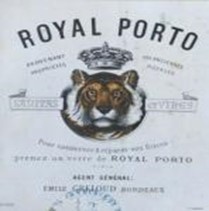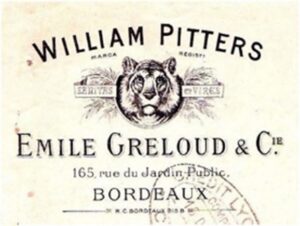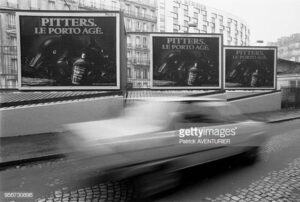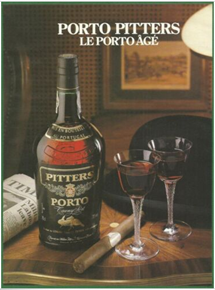ExploreOur History
1920
Founded over a century ago in 1920, Pitters remains fully dedicated to the tradition of producing Port wines from the traditional grape varieties of the Douro Valley..
The brand William Pitters was created on 14th January 1920 by Émile Greloud & Cie, a renowned trader from Bordeaux who began operating in 1887.
Greloud hasd been commercializing Port wines since 1888 under the name ‘Royal Porto’. Its portfolio at the time also included the brands ‘Royal Madére’, ‘Royal Malaga’, ‘Royal Alicante’, ‘Royal Moscatel’, ‘Royal Muscat’, ‘Malaga Royal’ and ‘Royal Xérès’. Émile Greloud imported the wines to Bordeaux and then sold them internationally.

One of the original Royal Porto labels.
William Pitters Port wines were, and are still today, produced in the Douro Valley, in the north east of Portugal. Besides being one of the world’s most beautiful wine regions, the Douro Valley was the first wine region to be demarcated and regulated by law, in 1756, making Port the oldest controlled denomination of origin.
William Pitters Port trademark was registered on 25th June 1925.
The tigers head has become the symbol of the William Pitters trademark for both Port wines and Bordeaux wines.

One of the first William Pitters Bordeaux wine labels
In 1926, a new law was introduced called the ‘Entreposto de Vila Nova de Gaia’, which made it mandatory for all the Port traders to have a physical warehouse in Vila Nova de Gaia, to age and distribute their wines from. This new piece of legislation which was considered groundbreaking at the time creating a more rigid structure to control and guarantee the quality of the port. This changed the dynamic for Pitters as a company meaning that could no longer age and store their wines in Bordeaux.
1928-1940
Pitters was renowned in the roaring twenties for being the Port wine with the “tiger face” and for the poster created in 1928 by Leonetto Cappiello, one of the greatest figures in the history of poster art. Famously known as the father of modern advertising, to this day, Leonetto Cappiello’s original posters are still collected around the world.
Following the economic prosperity of the twenties, the period between 1928 to 1940 was a golden era for Pitters Port.
1928 became a very significant year in the history of the company as Leonetto Cappiello designed and released the Two Tigers poster for Pitters Port.

Poster by Leonetto Cappiello in 1928 for Pitters Port.
Leonetto Cappiello is one of the greatest figures in the history of poster art and is known as the father of modern advertising.
Realizing that the boulevards of Paris were full of distractions, Cappiello rejected the fussy detail of Art Nouveau and focused on creating one simple image, often humorous or bizarre, which would immediately capture the audiences attention and imagination.
“Surprise,” he wrote, “is the foundation of advertising; it is its necessary condition.”
Cappiello’s inventiveness was remarkable, as he created nearly 1000 product posters. Today, his original posters fetch considerable prices at auction and are collected around the world.



Leonetto Cappiello’s had a distinctive signature style: to “shock” with unconventional colours and images, using mythical creatures, energetic poses, and extremely simple artworks to make the key subject “pop”.
Following on from these original Leonetto Cappiello posters, Pitters’ has maintained a close link to the world of art.
In 1930, a new poster featuring a tiger with an intrepid character and a case of Pitters Port wine was created. This artwork was not signed and the artist remained anonymous.

Poster created in 1930 for Pitters. Unknown artist.
This period was also marked by the launch of the first Pitters white Port (Porto Blanc).

Old William Pitters White Port label.
The tigers head (Tête de tigre in French) featured on all the labels, as well as the corporate letter heads and shipping documents. It became the symbol of the brand.

Old Invoice document dated 10th May 1932
Records show evidence of a close link between the company Émile Greloud and Quinta do Mirante (Castelo de Paiva, Douro Valley) circa 1930. At the time, Pitters launched some highly sought after Very Old Tawny Ports from the property dated between 1916 and 1921
After Émile Greloud died, in 1937, the company name Émile Greloud & Cie was changed to P. & J. Greloud to include the names of Émile Greloud’s sons, Pierre and Jean Greloud.
1941-1964
In spite of the previous successes of the brand, the following years proved to be very challenging.
After the heady heights of the 1920’s and 1930’s, the period that followed the Second World War saw the company face a significant decline in sales. Moreover, the arrival of whiskey and gin resulted in additional competition.
The firm continued to make outstanding wines, this time releasing a series of Vintages from, 1944, 1953, 1959 and the 1963.
1964
In 1964 the company was acquired by Bernad Magrez, a prominent Bordeaux entrepreneur, who re-launched the brand and traditions of the Pitters Port house.
Bernad Magrez established William Pitters International, based in Lormont, in Bordeaux.
The entrepreneur created the Myth campaign for Pitters featuring a shark with a 17-carat gold eye.
Subsequently a reproduction of the label was produced as part of an outdoor billboard campaign. The advertising caused quite a stir, attracting lots of media coverage. People started climbing up ladders and scraping the gold leaf off the posters!
This campaign had an impressive impact and contributed greatly to Pitters Port awareness in France and subsequent sales in French supermarkets.

Outdoor Myth campaign in Paris.
In 1969 the firm witnessed a strong development of William Pitters’ Port business.

Advert campaign thought to date from circa 1987.
The firm registered Pitters Gold Reserve in 2000 and Pitters Tawny in 2004.
2005
In 2005 Wiliam Pitters International was sold to French drinks group Marie Brizard Wine & Spirits, also based in Bordeaux.
The brand suffered as it was not deemed a priority brand, with low levels of promotional activity and brand activation resulting in decreasing sales. Against this adversity, Pitters still maintained its position as the #2 Port brand in the French market.
2019
In 2019, Adrian Bridge, Managing Director of The Fladgate Partnership, secured the purchase of the Pitters Port business, bringing the brand closer to its roots in the Douro Valley.
The Fladgate Partnership is a leading player in producing special category Port, owner of four of the main and most distinguished Port houses Taylor’s, Fonseca, Croft and Krohn, sold in over 105 countries.
With the acquisition, its new owners initiated a plan to bring Pitters to the forefront of the French market and other key countries worldwide.
2020
In 2020, Pitters celebrated its 100th anniversary. The Centenary was an opportunity to celebrate Pitter’s achievements, re-positioning the brand in the market with its greatest strengths.
In the year of its 100th anniversary, Pitters is presented in the market with a new and refreshed image and labels.
The new image brings back the tiger face, leveraging the spirit of the tiger that was present at Pitters first labels. This new image reinforces the values of this timeless and original brand, preserving Pitters individual identity, its history and tradition.
A century later, in 2020, Pitters still embodies its feline state of mind, expressed by the intrepid character and the aromatic power of its wines.

